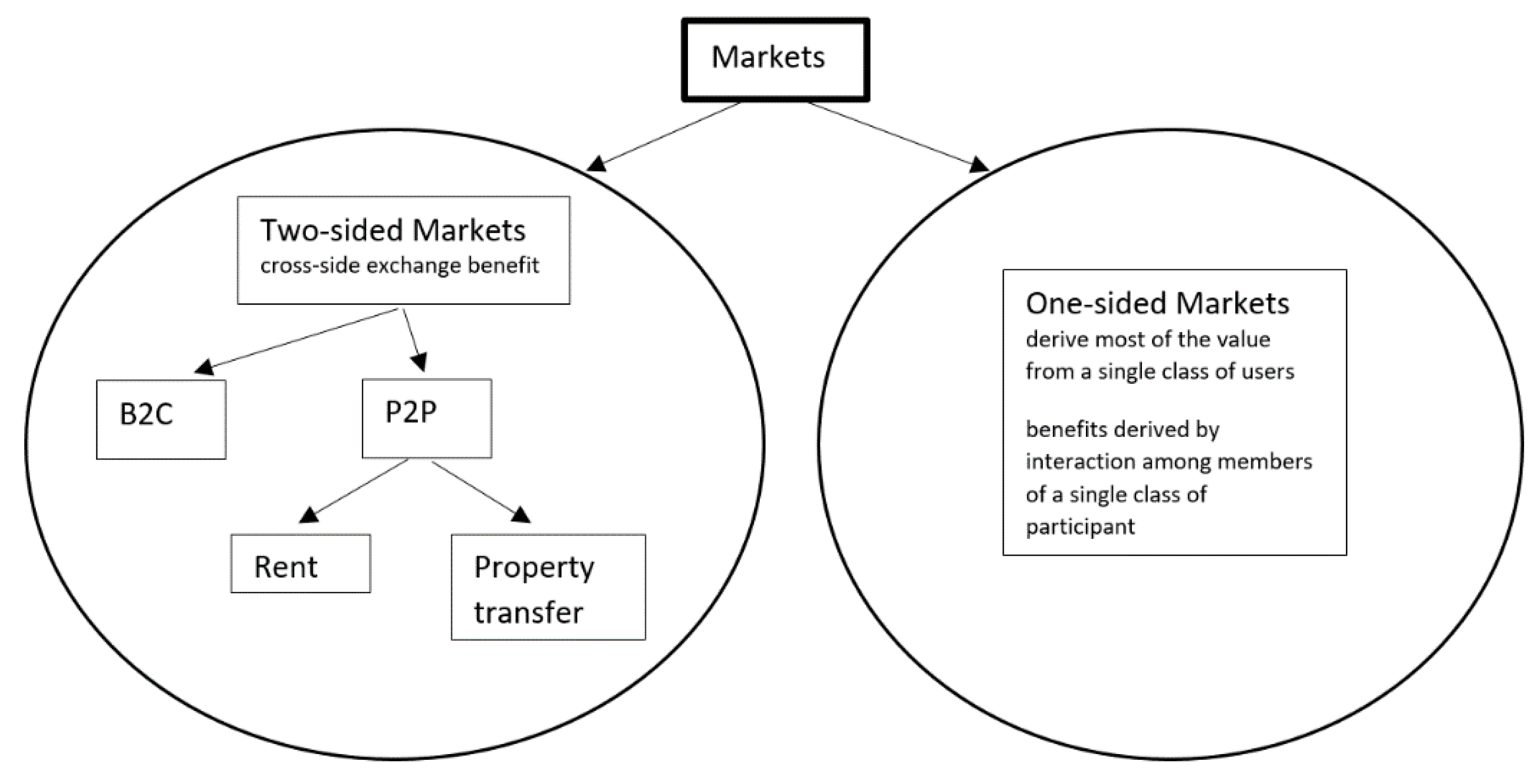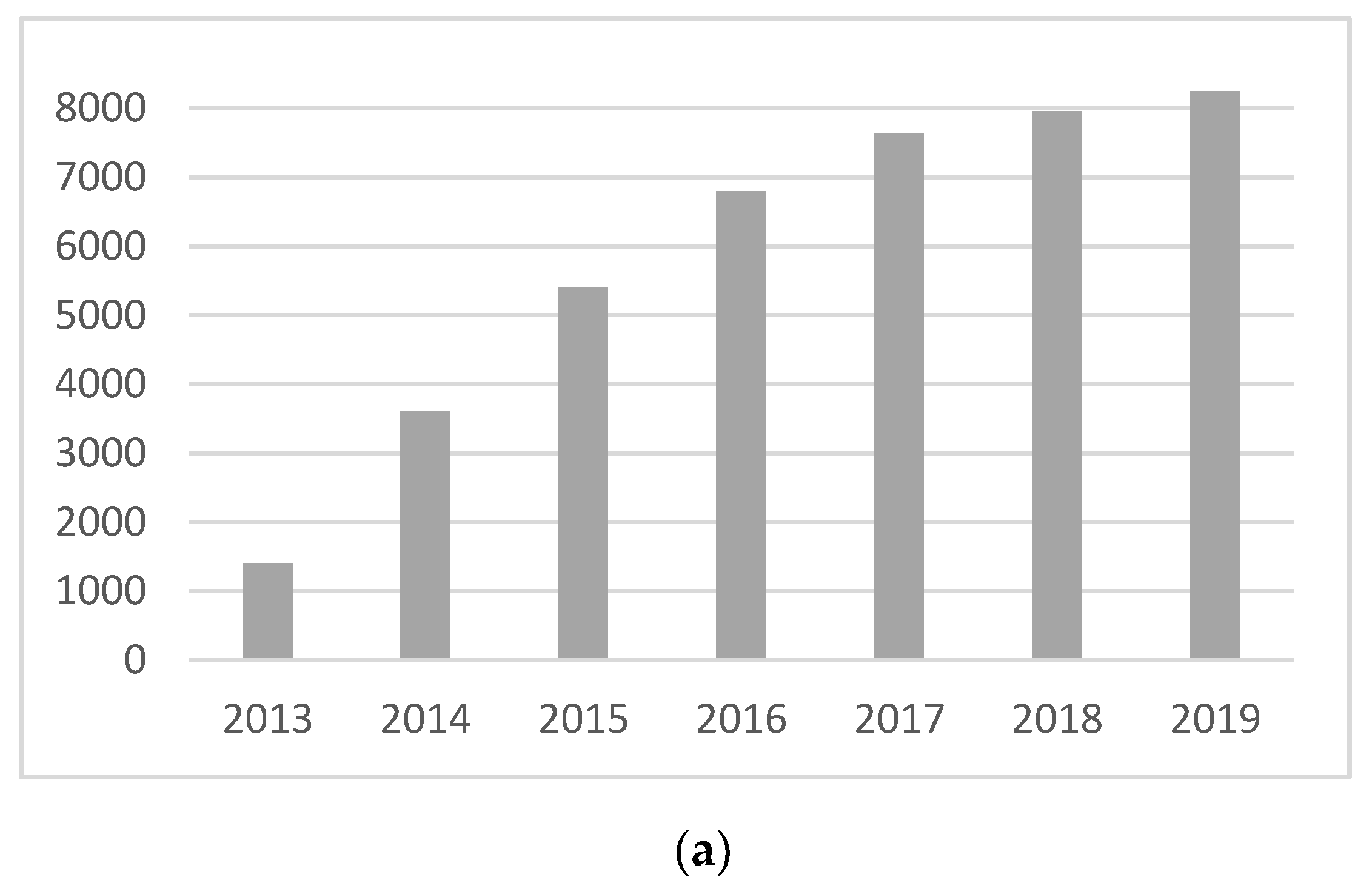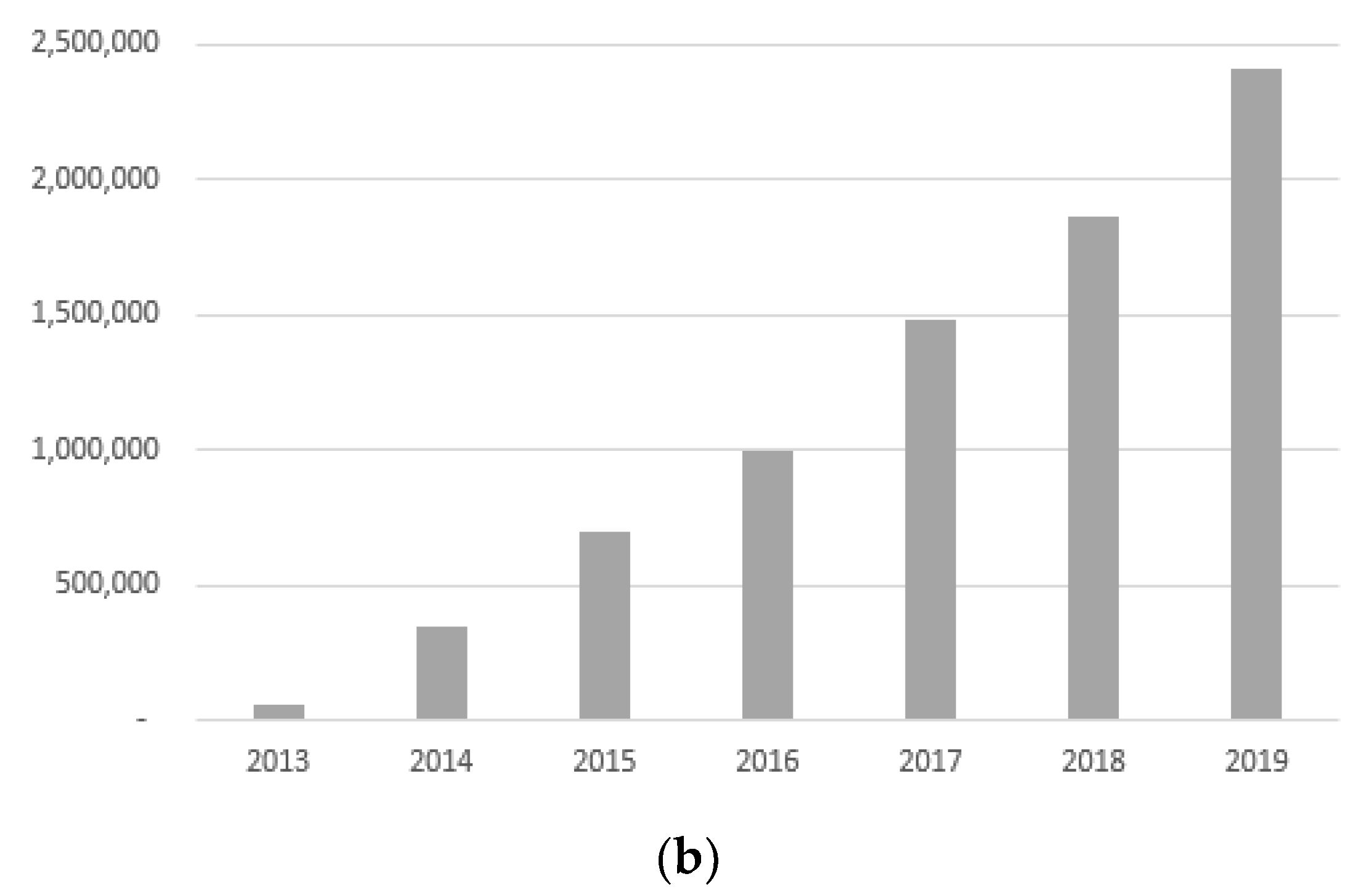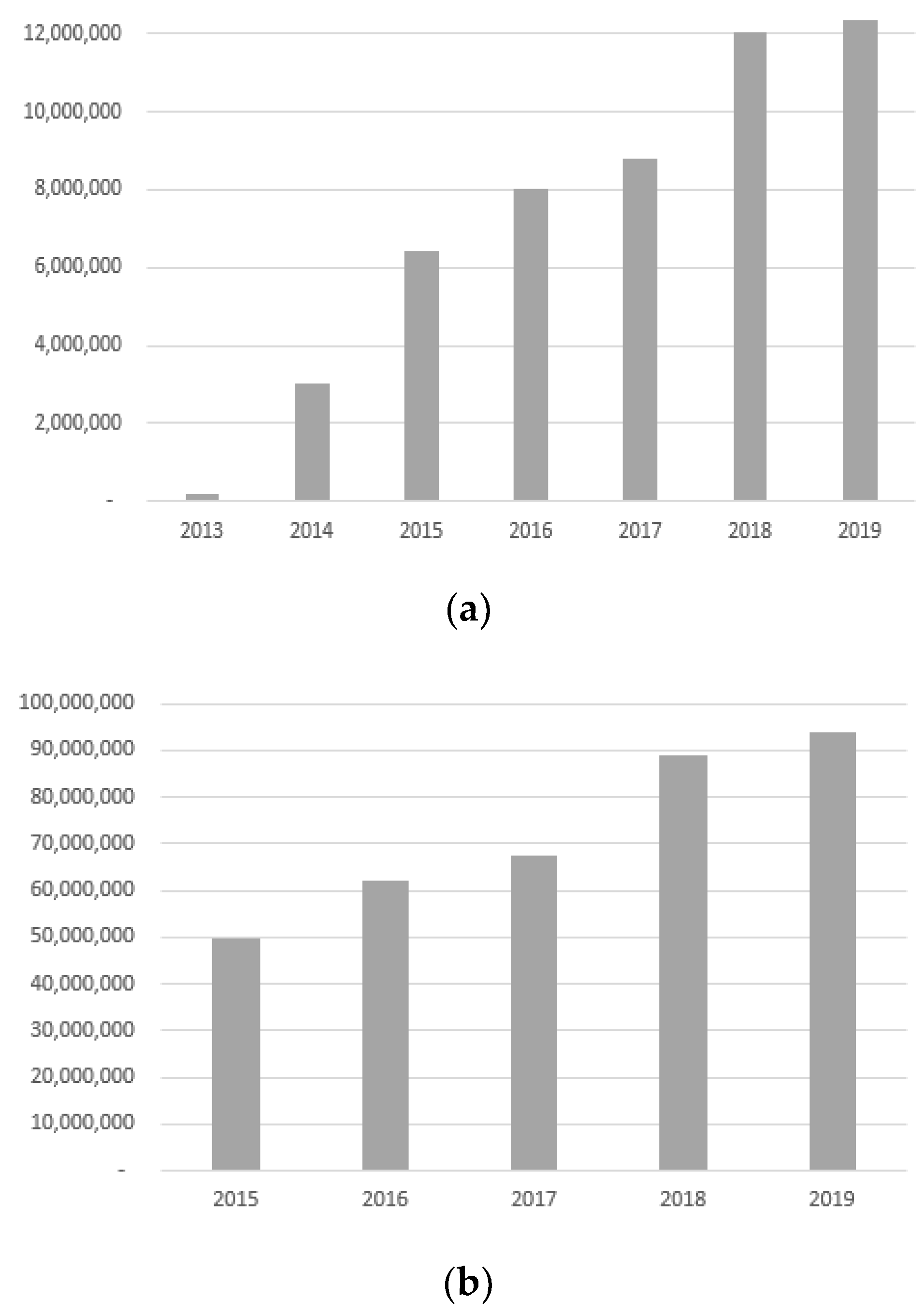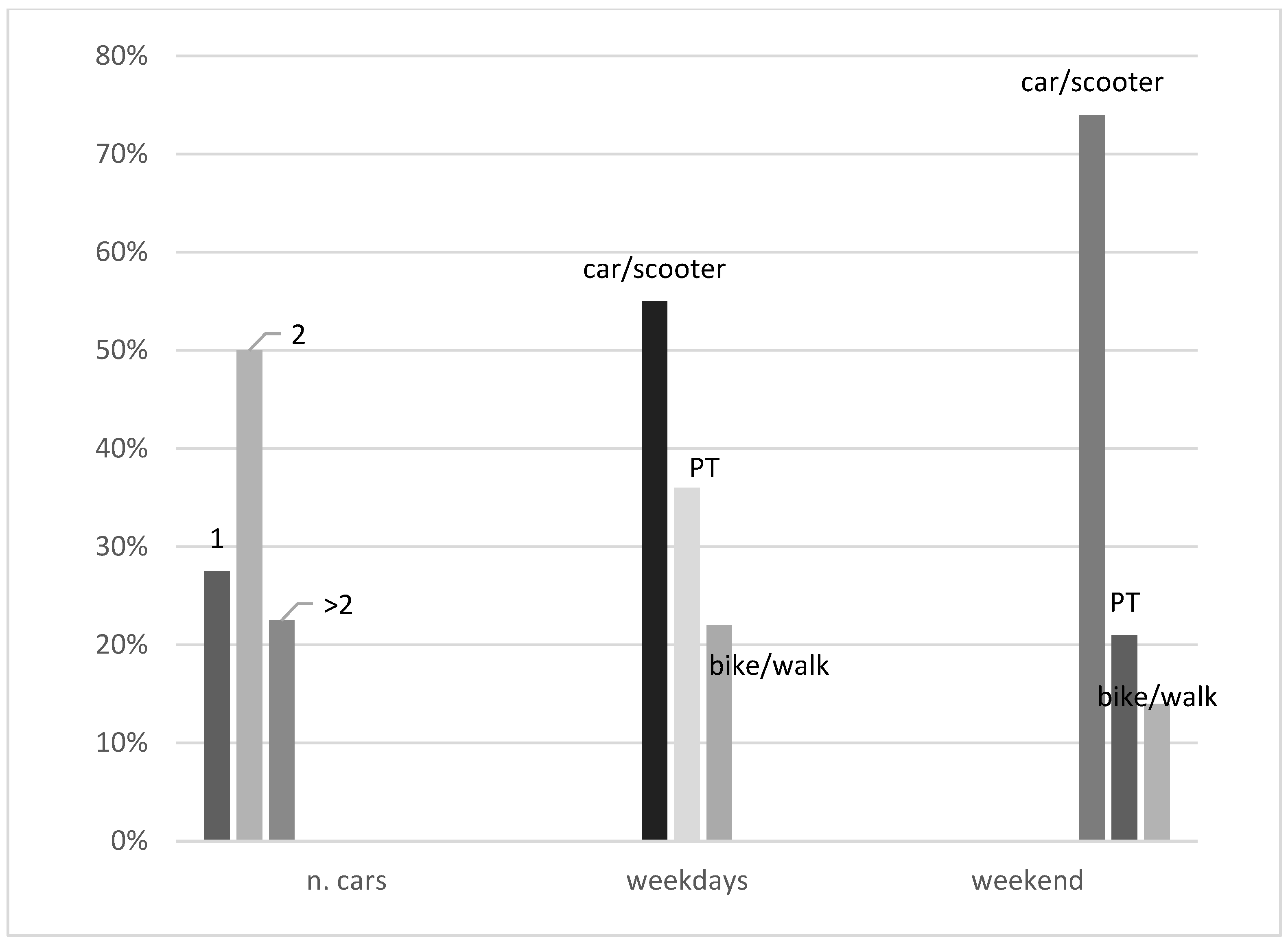1. Introduction
Air pollution produced by anthropogenic activities including transport is a risk factor for human health and ecosystems. In 2013, the European Union established two objectives: to achieve full compliance with the legislation in force in the territory of the Union by 2020 and to achieve full compliance with the levels recommended by the World Health Organization by 2030 [
1]. However, the 2020 report of the National System for Environmental Protection [
2] shows that in Italy in 2019 both limit values and target values were largely exceeded, in particular with respect to particulate matter and ground-level ozone. Moreover, according to the 2020 report of the Italian Institute of Training and Research for Transport [
3], the mobility demand in Italy is increasing. In the last three years, the number of trips per day has increased by 8%, while the number of passengers*km has increased by 14.3%. Moreover, most journeys are made by car or scooter (64%), and the pandemic crisis has further intensified the use of motorized private vehicles. Indeed, the Italian motorization rate is among the highest in Europe, and in 2019, it reached an all-time high: 65.6 for cars and 11.4 for scooters. Carsharing (CS) services could be a viable solution to the need of ensuring high accessibility levels while decreasing the negative externalities caused by the private use of motorized vehicles. The empirical evidence, in fact, proofs that CS helps to reduce car ownership [
4,
5,
6,
7,
8,
9,
10,
11,
12,
13], favors the joint use of shared vehicles and public transport [
13], favors active transport [
12] and reduces congestion, air pollution [
14] and parking search times in urban centers [
15,
16].
The history of CS in Italy is relatively recent compared to countries such as Switzerland, Germany, Austria and the Netherlands where CS has been offered since the 1980s. The launch of CS in Italy is traced back to 2001, when the Car Sharing Initiative (ICS), an association of municipalities supported and funded by the Ministry of the Environment, started promoting and supporting CS as a means toward sustainable urban mobility. The free-floating CS services arrived much later, in 2013, and from Milan, where they were initially offered, they quickly spread to the other largest Italian cities. CS is constantly evolving thanks to the innovations of the Information and Communications Technology sector, making the service more flexible and simple (location, booking, payment and opening of the vehicle are now generally done through the mobile phone) and, due to the changing preferences of consumers, more favorable toward using shared vehicles as an alternative to owning one. The studies focused on the supply and demand of CS in Italy are not numerous and do not report on how both the supply and the demand for CS have changed over the last few years. The objective of this paper is twofold. On the one side, we update the description of the CS services offered in Italy. On the other side, we review the literature on peer-to-peer carsharing (P2PCS) and analyze its potential demand in Friuli-Venezia Giulia, a less densely inhabited Italian region. This research is further justified by the fact that there are very few studies on the motives for joining and for not willing to join a P2PCS and there are no studies analyzing this topic with specific reference to less densely inhabited areas. Managers and policy-makers will benefit from our research because it detects the psychological barriers preventing the P2PCS uptake in Italy and allows better designing segment-specific marketing activities and regulatory and fiscal policies aimed at fostering participation rates.
4. Supply and Demand of CS in Italy
The CS market in Italy started about 20 years ago and has significantly changed over time, developing from its initial phase, characterized by extemporaneous local initiatives, to a consolidated mobility system offered in most of the largest Italian cities and in several medium ones. The largest operators providing CS services in Italy in 2019 were:
Sharenow, with a fleet of 2815 vehicles available in Milan, Rome, Turin and Florence. Sharenow is a German company providing carsharing services in urban areas in Europe and formerly in North America. It is a joint venture of Daimler AG and BMW, which in 2018 merged their carsharing companies, car2go and DriveNow, respectively. It has over four million registered members and a fleet of over 14,000 vehicles in 18 cities across Europe.
Enjoy, with a fleet of 2550 vehicles available in Milan, Rome, Turin, Florence, Bologna and Catania. Enjoy is an Italian company founded by ENI and renting only Fiat 500 cars provided by two long-term car rental companies, Leasys and Ald Automotive. Enjoy started its business in Milan in 2013, in 2014 it provided the service also in Rome and Florence, and it is now the second-largest carsharing company in Italy.
Share’ngo, with a fleet of 1164 electric vehicles available in Milan, Rome, Florence and Modena. Share’ngo is an Italian-Chinese company that started operating in 2015 in Milan with the first fully electric, free-floating carsharing service. One year ago, the company was sold to a Dutch entrepreneur. Since then, both the fleet and the service were initially downgraded and then suspended, the main problems being the financial sustainability of the company and the high percentage of damaged cars.
At the end of December 2020, Blue Torino, a CS operator founded by Vincent Bolloré who started providing a station-based service in Turin in 2015 with a fleet of electric vehicles produced in Italy and 430 charging stations, also exited the market due to the high losses accumulated over time (EUR 15 million in 2019). A new operator, Leasys, a long-term car rental company, has acquired Blue Torino’s license and charging network to provide the service with a fleet of 500 electric vehicles produced by FCA. The new operator is going to redesign the service, expanding the charging network to 550 stations and increasing the number of reserved parking spots to 560.
The total number of shared vehicles in Italy has significantly increased since 2013 and was about 8250 in 2019 (
Figure 2a). The free-floating fleet grew by 3.3% between 2018 and 2019 reaching 7009 vehicles, while the number of electric vehicles used for free-floating services was 1586, slightly lower than the figure recorded in 2018 (1742). The station-based fleet grew by 6.9% compared to 2018, and the share of electric vehicles increased from 33% in 2018 to 39% in 2019. The environmental sustainability of the shared fleet is significantly higher than that of private vehicles. In fact, in 2019, the percentage of EURO 6 shared vehicles was 99%, while the percentage of EURO 6 private vehicles was 24%. The average age of the shared-vehicles fleet was 1.2 years in 2019, much lower than the average age of the private-vehicles fleet, which was 11.5 years.
The total number of members was slightly lower than 2.5 million in 2019, with a positive trend that has not decreased over time. Recently, the majority of CS operators have started offering both free-floating and station-based services so that most CS users in 2019 had the possibility to choose between both service types using the same membership. The higher flexibility guaranteed by this opportunity increased the number of members by 30% between 2018 and 2019 (
Figure 2b).
The total number of rentals was 12.25 million in 2019 (
Figure 3a). Free-floating rentals were about 12 million, in line with the figure recorded in the previous year. Milan, Rome and Turin, which are the largest Italian cities, recorded the highest number of rentals, 6.2 million, 3.2 million and 1.7 million, respectively. Station-based rentals had always been smaller than free-floating, however, in 2019, they grew by 34% compared to the previous year. Station-based services proved an effective mobility option, especially in medium-size urban areas.
The total number of kilometers traveled significantly increased in 2019, reaching 94 million (
Figure 3b). The distance traveled with free-floating services, which on average was 7.4 km per rental, increased by 9.9%, about three times the growth of the rentals, improving the financial sustainability of this type of CS. The opposite trend was recorded for station-based services, with an average distance traveled of 25.2 km, decreasing by 18% compared to 2018. More than half of the free-floating rentals (63%) lasted less than 20 min, while the station-based ones lasted much longer, with an average travel time of 178 min. The average number of times a car was rented per day through a free-floating service was four, in line with the value recorded in the previous year. The average rental time of a station-based car over the 24 h was 13% which is also in line with the value recorded in the previous year.
Although the Italian carsharing market is characterized by remarkably positive trends with respect to members, rentals and kilometers traveled, the Share’ngo and the Blue Torino business cases are emblematic of how the scalability of the service is risky and difficult, even more so if the market to be served is made of less-densely inhabited areas. Indeed, although currently the CS services are mostly offered in large cities, they would be even more useful in rural areas where public transport services are less frequent if not completely lacking. In these areas, P2PCS might be more successful and sustainable than B2CCS. In Italy, however, P2PCS is a new business model in the initial phase of its life cycle. It started in 2018 and is currently offered by two platforms, Auting and Genial Move, with a total of 17,000 members, 1600 cars and 4150 rents.
5. Potential Demand for P2PCS in Italy
To study the potential demand for P2PCS in Italy and more specifically in less-densely inhabited regions, we carried out a survey via face-to-face interviews in Friuli-Venezia Giulia, a northeastern region bordering Austria and Slovenia.
5.1. Method
In order to collect the data, we used a four-part structured questionnaire. In the first part, we asked about the interviewee’s mobility habits (frequency and means of transport used on weekdays and weekdays). In the second part, we asked whether the interviewee would be willing to use a CSP2P service instead of the transport mode currently used. In the third part, we asked which factors would favor and which factors would prevent the use of CSP2P by the interviewee. We proposed the following items asking to state which ones would be a source of discomfort in using the service:
Damaging the car;
Car might be stolen while rented;
Need of cleaning the car;
Renting a soiled car;
Being responsible for the owner’s belongings;
Need of refueling the car;
Facing time constraints.
We also asked what they would like to know in order to rent a car, and we proposed the following items:
The owner’s profile with the users’ opinion;
The vehicle profile with the users’ judgment;
How to check fuel consumption and mileage;
If there is a daily mileage limit;
How far in advance should the vehicle be booked;
If the car is clean before it is delivered;
If the car can be returned to a place other than where it was picked up;
Who to call or how to replace the car in case of breakdowns.
Additionally, we asked why they would be willing to rent a car, and the respondents could choose among the following items:
Owning a car is too expensive;
Maintaining a car takes too long;
I don’t have a garage;
Owning a garage is too expensive;
Finding parking is difficult;
I could choose among different types of vehicles;
It is more convenient than the bus;
It is less expensive than taxis.
Finally, in the fourth part, we collected data about the socio-economic characteristics of the respondent.
We carried out 200 face-to-face interviews in December 2019 in gathering places such as squares, shopping centers and transport network hubs (railway stations, bus stations, bus stops) of the city and provinces of Trieste (38%) and Udine (62%). In the following sections, we provide a descriptive evaluation of the data collected.
5.2. The Sample
The sample, equally divided between males and females, included 200 individuals: 9% were aged between 18 and 24, 35% between 25 and 44, 39% between 45 and 64, and 17% were over 64 years old. Most of the individuals interviewed worked as employees (47%) or self-employed (9%), students represented 19% of the sample, retired and housewives accounted for 18% of the sample, while the unemployed amounted to 7% of the sample. With respect to the educational level, 48% of the respondents had a university degree, 35% had a high school diploma, while 18% had a lower middle school diploma (
Figure 4).
All respondents had a driving license. On average, the number of cars available for each member of the respondents’ household having a driving license was 0.5. The car was the transport mode most frequently used by 49% of the sample during weekdays and by 70% of the sample during weekends. The second most frequently used transport mode was the bus, used by 36% of respondents on weekdays, but only by 21% of the sample during weekends (
Figure 5).
5.3. Results
Half of the sample knew what a CS service is. CS knowledge is significantly influenced by respondents’ age, educational level, gender and occupational status. The majority of the respondents aged between 25 and 44 (77%) were familiar with this form of mobility, followed by individuals aged between 18 and 24 (61%). A large percentage (65%) of interviewees with a bachelor’s or a master’s degree knew what a CS is, while only 35% of those with a lower educational qualification were familiar with this form of mobility. The majority of the students interviewed (76%) knew what a CS service is, while almost none of the interviewed who were retired were familiar with it (
Table 4). None of the respondents was aware of what a P2PCS is and of the fact that it is already possible to use the service either as a car owner or as a car renter through two Italian platforms.
One-fourth of the sample answered that they would use CSP2P if available. This potential penetration rate is larger than the threshold estimated by Hampshire et al. [
35] for a successful and financially sustainable P2PCS. According to the authors, the threshold is equal to 10 potential members living within a 0.4 km radius of each single car location, corresponding to 0.8% of the population in an area with 10 residents/acre (40 residents/km
2). Since the population density of Friuli-Venezia Giulia is 150/km
2, a potential demand of 25% of the population is well above the minimum percentage needed for the provision of a viable and sustainable P2PCS system.
The respondents most likely to use the service were women (differently from references [
26,
31,
32,
33]), having a master’s degree (similarly to references [
25,
26,
31,
32,
33]), aged between 25 and 44 (consistently with references [
24,
26,
31,
32,
33]), with strong environmental sensitivity (in line with reference [
26]), frequently using public transport services (similarly to references [
25,
33]) during weekdays (
Table 5). Moreover, the differences in the percentage of individuals willing to use P2PCS by each socio-economic factor (gender, education level, age, environmental sensitivity and mobility habit) are statistically significant according to the chi-squared test we performed. However, the descriptive approach we used to report the data only depicts the status quo and does not allow us to interpret these differences as cause-effect relationships between the socio-economic factors analyzed and the willingness to use P2PCS services. Nevertheless, these results are largely consistent with the evidence reported in the literature on the most important socio-economic characteristics influencing the willingness to use CS and P2PCS with the exception of gender since, according to the evidence reported in the literature, males are typically more favorable than female toward P2PCS adoption.
The majority of the respondents in favor of P2PCS stated that they would be willing to pay EUR 5 per hour to use it (82%), 10% would be willing to pay less than EUR 5, and 8% would be willing to pay EUR 10 per hour. The values stated by the majority of the respondents are smaller than the rent fees charged for B2CCS services in Italy (EUR 11.4/h,
https://www.share-now.com/it/it/), however, P2PCS are generally cheaper than B2CCS (about EUR 1.6/h), with EUR 40 as the average daily fee (based on data published by Auting at
https://auting.it/), and they are also smaller than the willingness to pay of the sample.
The type of vehicles that they would most likely rent is city cars (58% of the segment willing to use P2PCS), followed by family cars (30% of the segment willing to use P2PCS).
The P2PCS service would be mainly used during weekdays as an alternative to the private car or the bus (
Table 6). Individuals traveling mostly by car would substitute on average 62% of their weekday trips and only 3% of their weekend trips with P2PCS. Individuals traveling mostly by bus would replace on average 80% of their weekday trips and 18% of their weekend trips with P2PCS. People who move on foot would substitute 34% of trips on weekdays with P2PCS. Journeys made by motorcycle, scooter, train or bicycle would not be replaced by CS.
The reasons most frequently stated for willingness to use P2PCS were that it is more convenient and flexible compared to public transport (in line with references [
24,
34]). The fact that there is no need to own a garage or to look for parking once having returned home (consistently with reference [
33]) and the greater cost-effectiveness of P2PCS compared to owing a car (similarly to references [
24,
26,
31,
33,
34]) are also deemed important factors (
Table 7, first column).
The most frequently cited concerns related to the use of the service were the time constraints in the collection and return of the vehicle and the need to refuel the vehicle before returning it (
Table 7, second column).
Critical factors for willingness to use the service were the availability of the vehicle description and users’ opinion about the characteristics of the vehicle. In addition, the possibility of returning the car to a place other than the one where it was picked up was cited as a very important condition in order to be willing to use the service. Knowing in advance who to contact in case of malfunctions, unlimited daily mileage, transparent methods of checking fuel consumption and how much in advance it is necessary to book the vehicle were also relevant factors influencing the willingness to use the service (
Table 7, third column).
The main reasons why 75% of the sample stated that they would not use the service were the time constraints regarding the place and time of getting and returning the car and the need to refuel the vehicle before returning it (
Table 8, first column).
However, 53% of those who stated that they would not use the service said that under certain conditions, they would change their mind and they would actually rent a car. The conditions deemed most relevant were the possibility of not having to book the vehicle in advance, the guarantee of assistance in case of vehicle malfunctions and the possibility of returning the vehicle to a place other than the one where it was picked up. Additional critical factors were unlimited daily mileage and information on how fuel consumption is measured (
Table 8, second column).
6. Discussion and Conclusions
6.1. Discussion and Contribution
Internet-based exchange markets are shifting consumers from owning resources to sharing their consumption. Collaborative consumption is spreading also within the transport sector where carsharing, either in the business-to-consumer setting or in the peer-to-peer setting, is increasing its market share compared to other mobility systems.
The CS market in Italy started about 20 years ago and is now a consolidated mobility system provided in most of the largest Italian cities and in several medium ones. The Italian CS market, in fact, is characterized by remarkably positive trends with respect to the number of members, rentals and kilometers traveled, free-floating being by far the most diffused CS type if compared to the station-based one. P2PCS, instead, is offered only by two platforms and is seldom known and used, especially in rural areas where it could represent a viable alternative to the ownership and use of private vehicles and to public transport services.
Our research describes the current status of the Italian P2PCS perception distinguishing between the motives of individuals willing to use the services from the motives of individuals not willing to use it. Moreover, we investigated the potentialities of this innovative form of CS in a less densely inhabited area, the Friuli-Venezia Giulia region.
According to our results, 25% of the individuals we interviewed would be willing to use a P2PCS service if available, confirming its good potentialities also in less inhabited regions. We found that the willingness to use CS is significantly influenced by gender, level of education, age, environmental sensitivity and frequency of public transport service use. The motives for willingness to rent a car are mainly related to convenience and cost savings compared to using public transport services and owning a car, respectively. However, the lack of trust among individuals is one of the most critical issues in personal vehicle sharing. As stated by Shaheen et al. [
27], it requires a user rating and feedback system, operator screening and selection and social networking besides vehicle quality assurance and responsive customer service. The evidence reported in the literature is confirmed by our results, however, the sources of concern in using P2PCS expressed by the sample we interviewed are also related to time constraints and coordination issues, assistance in case of malfunctioning and liability.
Technology could play a crucial role in overcoming these problems since unattended access promotes user safety and reduces potential access issues caused by a lack of coordination among individuals. Technologically advanced platforms could also avoid the need of booking the car in advance. Moreover, they could enable direct interaction between renters and car owners allowing them to reach an agreement not only on the place where to return the car, a critical factor according to our results, but also on other features of the service deemed important by the demand side of the market (daily mileage limit, refueling, cleaning conditions).
However, according to our analysis, the largest obstacle for the development of this form of CS in Italy is the lack of awareness of the existence of the service. Indeed, although 50% of the sample knew what a CS service is, none of the individuals we interviewed knew what a P2PCS is, and nobody was aware that there are already two platforms providing this service in Italy.
6.2. Management and Policy Implications
On the basis of our results, we conclude that the existing P2PCS platforms should intensify the promotion of their services; to this aim, they should use a large spectrum of different channels, including social media. Moreover, in order to increase their visibility, they could engage in public-private partnerships with local administrators and public transport providers. They should provide a more detailed description of the characteristics of the service, informing not only on how the service works but also on how both car owners and renters could benefit from sharing a private vehicle, emphasizing also the favorable motives stated by our sample. Moreover, in order to launch and strengthen the service in less densely inhabited areas, they should at least temporally grant special discounts to new members living in rural areas, applying for public subsidies in light of the higher accessibility level guaranteed due to the service offered.
Local administrators could support the uptake of this new form of CS providing P2PCS users with parking discounts, dedicated parking spots and access permits to urban limited traffic zones. These policies could be further fine-tuned to support the use of P2PCS for trips originated from less densely inhabited areas that are not served by public transport services. Moreover, they could be differentiated according to the environmental impact of the shared vehicles. Supporting P2PCS as a supplement to public transport would create a more flexible and efficient transport system instead of a system where modes are competing against each other.
Financial constraints and increasing mobility demand require public administrators to replace the public service monopoly with multi-actor collaboration across municipal borders and private market domains. Integrating different transport modes by including P2PCS in multimodal hubs via multimodal platforms (MaaS) has the potentiality of increasing the accessibility of rural areas, reducing the financial burden of local public transport, using more efficiently the private fleet and the road network and reducing the environmental impact of the transport sector. Planning authorities and other actors in the public domain play a crucial role in achieving all these aims. They need to monitor the social and environmental impact of this new form of mobility and drive its uptake so that it continues lowering the overall car use and ownership while fostering accessibility and environmental sustainability.
6.3. Limitation and Future Work
The main limitation of our research is the small size of the sample we interviewed. In order to overcome this limitation, we will collect additional interviews and we will focus on members of the P2PCS platforms offering the service in Italy. Future work should also detect to what extent P2PCS enhances accessibility and social inclusion and whether it is effective in reducing the number of cars within urban areas. We will also try to understand why in our case study females are more in favor of P2PCS than males since this result is markedly different from the evidence reported in the literature. Finally, we will analyze the impact that the COVID-19 pandemic has produced in the CS market since in Italy it has dramatically reduced the demand for CS services.
